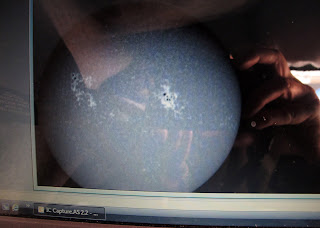My last day in Tucson I drove up to the Kitt Peak National Observatory and National Solar Observatory. It was one scary drive and all vehicles could only drive 25 mph. Believe me that was too fast for the likes of me and my camper. After reaching the top I now feel I can drive anywhere. You can see how high my drive took me.
I began on the desert floor in the Tohono O’odham Reservation. Quoting from a sign in the center, “The people living in the Kitt Peak area during the 17th century belonged to a loose collection of independent villages that spoke a variety of related dialects. The considered themselves collectively to be the Tohono O’odham (THO-ho-no AH-ah-tham), which means “the Desert People.” Their Piman neighbors called them papahvi-o-otam, the “Bean People,” for their use of tepary beans. Spanish missionaries translated this as “Papago”, a name which the O-odham was generally known for over 200 years. In 1986, the Tribal Council officially reestablish Tohono O’odham as their true name. “I had always known them as Papago since my stepfather worked there before the name change. He always supported them as much as possible by buying many of their baskets which I cherish to this day. When a qualified tribe member became qualified for his job my family moved on to another government position in Big Spring, Texas. Even today tribe members are given first priority for jobs at Kitt Peak as part of the original agreement for the use this of their land.
In the distance you can see the sacred mountain called Baboquivari home of I’itoli, their Creator and Elder Brother. It is 7,730 feet high. On a climbing blog I found the following information: “The rock god I'itoli, also spelled I'itoi, lives in a cave on the northwest side of the mountain that he enters by a maze of passages. Legend says he came into this world from a world on the other side, leading his people, whom he had turned into ants, through an ant hole. He then changed them back into the Tohono O'odham people. The Tohono O'odham still regularly make pilgrimages to the cave, leaving offerings and prayers for I'itoli.”
I also found it interesting that the reservation is the second largest in the U.S and they have always lived there. There were not exiled or relocated like so many other tribes.
My first stop was the Visitor Center with a few displays and a talk. Here I am in front of an infrared camera taking a self portrait.
Another one demonstrating the focus which I could never get right because if I had I would have been right side up. Oh well, it was fun anyway.
There are 26 different telescopes on the mountain and I went into 2 of them. The 2.1m telescope and the Mayall 4m telescope. The first was the 2.1m as shown below.
Inside I took these photos and it was very interesting but after a bit it became so technical I lost track to what was being said. It was a lot like reading an AGU Planets Journal, I’m good with the abstract and the photo but once into the articles I always become lost.
The next telescope was the Nicholas U. Mayall 4 Meter Telescope and the largest optical telescope on the mountain. The mirror weighs 30,000 pounds. It is the tall one in the center.
Place on the side of the visitor area says, “…has played an important part in the establishing the role of dark matter in the universe through observations of rotation curves of galaxies, in determinations of stellar radii from occulations, in understanding the dynamical structure of elliptical galaxies, and in determinations of the distance scale and large-scale structure of the universe.”
If I am remembering correctly the use of the telescope is free to all citizens. You only need to submit a proposal and have it accepted by a board and schedule a viewing time.
The other really cool telescope was the one for viewing the sun. I didn’t go inside because I thought it was closed, later I found out it was open. Bummer.
Here is a diagram showing the structure. Looks like a lot of it is underground.
Did you notice that little round done at the base of the right side of the solar telescope? That is there for the docents to use and teach. It was open and they had it set so I could view the sun. There were three ways to look at it. One was the lower eyepiece where I could see the sun flairs on the side of the sun.
The upper eyepiece was set to see sun spots. I used my camera up against the eyepiece and took this photo.
I expected to see more but the docent said that sometimes there are only a few. The 3rd way to view is through the computer which is actually they way it is viewed most of the time. Here is a photo I took of the computer screen showing the spots.
Below is a view of most of the complex as seen from the 4 meter scope. There are 26 in all, 2 of which are radio telescope similar to the ones in WV but much much smaller.
SKYWATCH HAS SOME NICE BLOGS YOU MIGHT WANT TO VIEW.
Subscribe to:
Post Comments (Atom)




















+DSCN5800+for+blog.jpg)

1 comment:
WIsh I could have joinedyou! Imagine it at night!!
Post a Comment